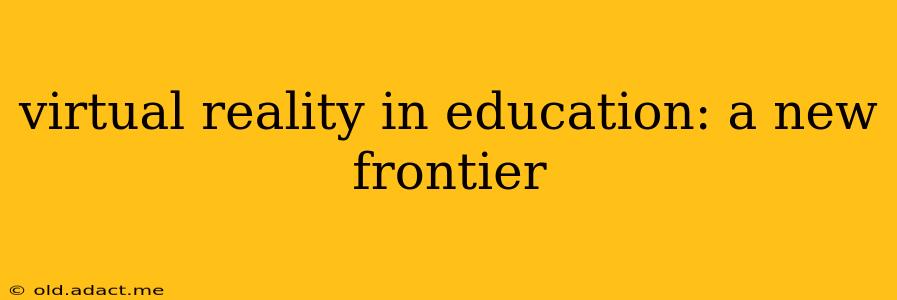Virtual Reality (VR) is rapidly transforming numerous sectors, and education is no exception. No longer a futuristic fantasy, VR is becoming an increasingly accessible and impactful tool, offering immersive learning experiences that can revolutionize how students learn and interact with educational material. This new frontier in education promises to enhance engagement, improve knowledge retention, and personalize learning in ways previously unimaginable. But what exactly does this mean for the future of classrooms? Let's explore the exciting potential of VR in education.
What are the benefits of using VR in education?
VR offers a multitude of benefits that traditional teaching methods struggle to match. The immersive nature of VR allows students to actively participate in learning, fostering deeper understanding and knowledge retention. Imagine dissecting a frog without the mess, exploring ancient Rome firsthand, or even experiencing the feeling of weightlessness in space – all from the comfort of the classroom. This level of engagement is unparalleled, capturing students' attention and making learning a truly memorable experience. Furthermore, VR can personalize the learning experience, catering to different learning styles and paces. Students can revisit concepts at their own speed, explore topics in greater depth, and receive immediate feedback, leading to more effective learning outcomes.
How can VR be used in different subjects?
The applications of VR in education are incredibly diverse, spanning numerous subjects and age groups. Consider these examples:
-
Science: Students can dissect virtual organs without the need for real specimens, conduct experiments in a risk-free environment, or explore the intricacies of the human body from the inside.
-
History: Walk through ancient civilizations, experience pivotal historical events firsthand, or explore historical sites without the constraints of time or geographical limitations.
-
Geography: Explore diverse landscapes and ecosystems, visit different countries, and gain a deeper understanding of the world around us.
-
Languages: Immerse yourself in a virtual environment speaking the target language, interacting with virtual characters and practicing conversational skills in a realistic setting.
-
Arts: Create virtual art installations, design 3D models, or explore different artistic styles and techniques in a fully interactive environment.
What are the challenges of using VR in education?
While the potential benefits of VR in education are substantial, certain challenges need to be addressed for widespread adoption. The initial cost of implementing VR technology can be a significant barrier for many schools and educational institutions. Moreover, ensuring equitable access to VR technology for all students, regardless of socioeconomic background, is crucial to avoid exacerbating existing educational inequalities. Furthermore, teacher training and professional development are essential to effectively integrate VR into the curriculum and maximize its educational potential. Finally, the potential for motion sickness and other physical discomforts among students must be carefully considered and addressed.
Is VR in education expensive?
The cost of VR technology varies significantly depending on the type of equipment, the scale of implementation, and the level of sophistication required. While high-end VR systems can be expensive, more affordable options are emerging, making VR more accessible to schools and educational institutions with limited budgets. Furthermore, the long-term cost savings associated with reduced reliance on physical materials and resources could offset the initial investment.
How effective is VR in education?
Numerous studies have demonstrated the effectiveness of VR in enhancing learning outcomes. VR's immersive nature fosters deeper engagement, leading to improved knowledge retention and a more profound understanding of complex concepts. Studies show that students using VR tend to display increased motivation, improved collaboration, and a more positive attitude towards learning. However, the effectiveness of VR in education also depends on factors such as the quality of the VR content, the pedagogical approach used, and the overall learning environment.
What are some examples of VR in education software?
Several educational VR software platforms and applications are available, offering a range of interactive learning experiences. These platforms provide immersive simulations, virtual field trips, and interactive games designed to enhance learning across various subjects. The specific software best suited for a particular educational setting will depend on the curriculum, the age group, and the learning objectives.
What is the future of VR in education?
The future of VR in education is bright. As technology continues to evolve and become more affordable, we can expect to see VR integrated into classrooms more broadly. The development of more sophisticated and engaging VR content will further enhance its educational potential. The use of VR in education is poised to continue evolving, creating more personalized, immersive, and effective learning experiences for students worldwide. From personalized learning pathways to collaborative virtual classrooms, the possibilities are limitless. The integration of VR into education marks not just a technological advancement, but a paradigm shift in how we approach teaching and learning.
